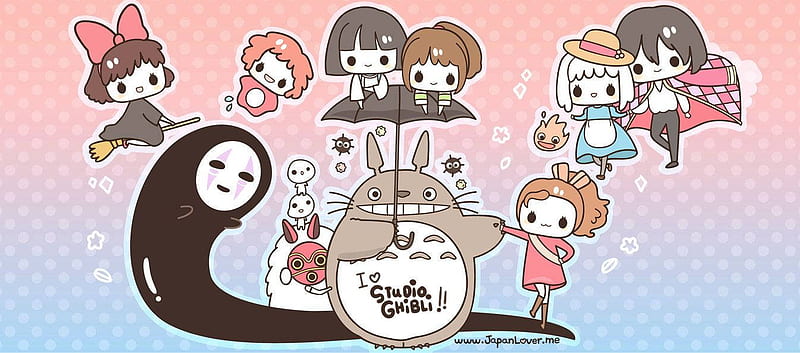An incredible Popularity – The Transformation from Forest Guardian to Kawaii Icon
 This captivating and popular design immediately made the character of Totoro almost more popular in the world of merchandising than as a film character. It was precisely the sales of the film's merchandise that saved Studio Ghibli from the risk of bankruptcy, and perhaps this was Totoro's curse/fortune. Especially as the film spread beyond Japan's borders, Totoro began to travel the world as a toy, gadget, illustration, or plush, often preceding the fame of his film, the production studio, or his creator. He transformed almost into a pop icon, detaching from his role as the film's magical helper and effectively becoming a mascot.
This captivating and popular design immediately made the character of Totoro almost more popular in the world of merchandising than as a film character. It was precisely the sales of the film's merchandise that saved Studio Ghibli from the risk of bankruptcy, and perhaps this was Totoro's curse/fortune. Especially as the film spread beyond Japan's borders, Totoro began to travel the world as a toy, gadget, illustration, or plush, often preceding the fame of his film, the production studio, or his creator. He transformed almost into a pop icon, detaching from his role as the film's magical helper and effectively becoming a mascot.
This characteristic increasingly turned Totoro into a mere gadget and distanced him further and further from his forest, from the messages of respect for the environment and nature, from simplicity, and above all, from the idea for which he was born. The kami Totoro lost his aura in favor of his cuteness factor, his 'huggableness' – in short, all those characteristics that made him popular not for what he represents, but exclusively for his aesthetics. “By replicating the work many times over, it substitutes a mass existence for a unique existence. And in permitting the reproduction to reach the recipient in his or her own situation, it actualizes that which is reproduced.” (Benjamin, 2008). Totoro ceased to be a spirit guardian in favor of being, today, a plush toy dressed in Dai clothes, another day an action figure, yet another a water bottle, or any themed gadget. His popularity has grown so much that many of the Totoro-themed items found around are not even approved by Studio Ghibli. Totoro has experienced and is experiencing the fate of all those fictional characters who become part of pop culture, like Mickey Mouse, Yoda, or Super Mario.
This happened precisely because of Totoro's Kawaii look. But what does kawaii mean exactly? It is a Japanese adjective that has several meanings: “cute” to “sweet”, from “tender” to “childish”, from “innocent” and “gentle” to “honest” and “soft”, and from “small” to “lovely” (Pellitteri, 2018, p.96). Kawaii can therefore be a concept that summarizes all those things, objects, or characters that make us feel one of these emotions and attract us for this reason. Japan deliberately supported the production of a “kawaii culture” and especially the export of its derivatives to change the narrative about Japan abroad, after the terrible reputation the nation had post-World War II due to the terrible actions perpetrated in Southeast Asia (Shafie, 2024, p. 341).

This promotion of cute, sweet, and positive content created a new image of Japan in the world, even in states where Japan had historically left deep wounds. South Korea and China are examples, where the negative image of imperial Japan has been partially replaced by the country's new pop image. Proof of this is that Hello Kitty is the tourism ambassador for Chinese tourists, and a huge amount of merchandise from Japanese media products is purchased in China (Shafie, 2024, p. 341). Our Totoro is a perfect example of this trend. The official character is in no way associated with Dai culture, but his popularity and his cute and sweet look have become a pretext to use him as a mascot promoting Dai culture and to sell him to local tourists visiting the splendid nature of Yunnan.
Image credit Totoro Toys: https://www.walmart.com/ip/OliaDesign-Anime-Totoro-Figure-12pcs-set-Action-Figure-Toys/195128182
Image credit Totoro Kawaii: https://www.peakpx.com/en/hd-wallpaper-desktop-erdso
 This captivating and popular design immediately made the character of Totoro almost more popular in the world of merchandising than as a film character. It was precisely the sales of the film's merchandise that saved Studio Ghibli from the risk of bankruptcy, and perhaps this was Totoro's curse/fortune. Especially as the film spread beyond Japan's borders, Totoro began to travel the world as a toy, gadget, illustration, or plush, often preceding the fame of his film, the production studio, or his creator. He transformed almost into a pop icon, detaching from his role as the film's magical helper and effectively becoming a mascot.
This captivating and popular design immediately made the character of Totoro almost more popular in the world of merchandising than as a film character. It was precisely the sales of the film's merchandise that saved Studio Ghibli from the risk of bankruptcy, and perhaps this was Totoro's curse/fortune. Especially as the film spread beyond Japan's borders, Totoro began to travel the world as a toy, gadget, illustration, or plush, often preceding the fame of his film, the production studio, or his creator. He transformed almost into a pop icon, detaching from his role as the film's magical helper and effectively becoming a mascot. 